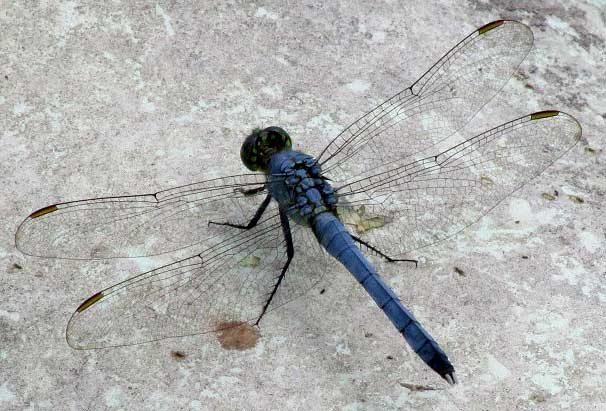Excerpts from Jim Conrad's
Naturalist Newsletter

from the August 3, 2014 Newsletter issued from the Frio Canyon Nature Education Center in the valley of the Dry Frio River in northern Uvalde County, southwestern Texas, on the southern border of the Edwards Plateau; elevation ~1750m (~5750 ft); N29.62°, W99.86°; USA
EASTERN PONDHAWK
A large, unusually thick-bodied, very blue dragonfly landed on a concrete culvert projecting into one of the ponds at Cook's Slough Nature Park on Uvalde's south side. That's him above..
Using Sidney Dunkle's Dragonflies through Binocularsit was easy enough to figure out that this was one of several species known as pondhawks, but there were two deep-blue pondhawk species with especially thick abdomens -- the Eastern and Western Pondhawks. In both species the males are blue while females are green. Pictures seem to show that our Uvalde pondhawk is dark blue like the Western species, while Dunkle's distribution map indicates that in our area we have the Eastern species, not the Western.
However, the species descriptions said that the cerci of Eastern Pondhawks are white while those of the Western species have black ones. Cerci are the two tiny, claw-like items visible at the very tip of the abdomen, in our picture clearly visible in the lower, right corner. Those cerci look more gray than white, but at least they're not black, so that agrees with the distribution map, making this the Eastern species. Therefore: Eastern Pondhawk, ERYTHEMIS SIMPLICICOLLIS.
Eastern Pondhawks occur throughout the eastern US and contiguous Canada, west to Nebraska and Arizona, plus the Caribbean, and south throughout Mexico to Costa Rica in Central America. It's common over most of its distribution and is considered to favor human-modified wetlands, which is exactly what the ponds are at Cook's Slough. This predisposition has enabled Eastern Pondhawks to become one of the most abundant species in the eastern US.
Pondhawks in general (genus Erythemis) are thought of as voracious and aggressive, sometimes taking prey as large as themselves, which they hold on to with three large spines on each middle and hind thigh. In our picture, remembering that the thigh is the upper, thicker part of the leg, you can see these three spines.
Among the pondhawks, of which five species occur in North America, the Eastern species is considered especially ferocious, attacking even each other. They remove great numbers of flying insects, including those thought of as agricultural pests. The male's vigorously defended territory consists of about five square yards (meters) of floating vegetation such as algae and duckweeds. Ours was patrolling a band of duckweed gathered up against the pond's bank.